To get there you have to clamber over bits of wood erected as a defensive mound. Lying between two banks a series of steps enable you to gain access to the habitable barricade that serves as a welcome area. It bears the name 'Saboté' ('Botched' in English) and is the gateway to a camp of protesters at Chambarans, a forest situated around sixty kilometres from Grenoble in eastern France.
Protesters have occupied the site in this ancient communal woodland since November 2014 in a bid to block plans to develop a Center Parcs holiday centre here. In July 2015 opponents scored a victory: an administrative court overturned the local state prefect's decree authorising the destruction of the wetland area which extends across part of the 200-hectare site where the group Pierres et Vacances wants to build cottages and a swimming pool under the distinctive Center Parcs dome. The holiday group has since appealed against the judgement. Locally, those for and against the Center Parcs project eye each other with mistrust as they await the next judicial round. Some local people have expressed considerable hatred towards the activists who now live on their doorstep.
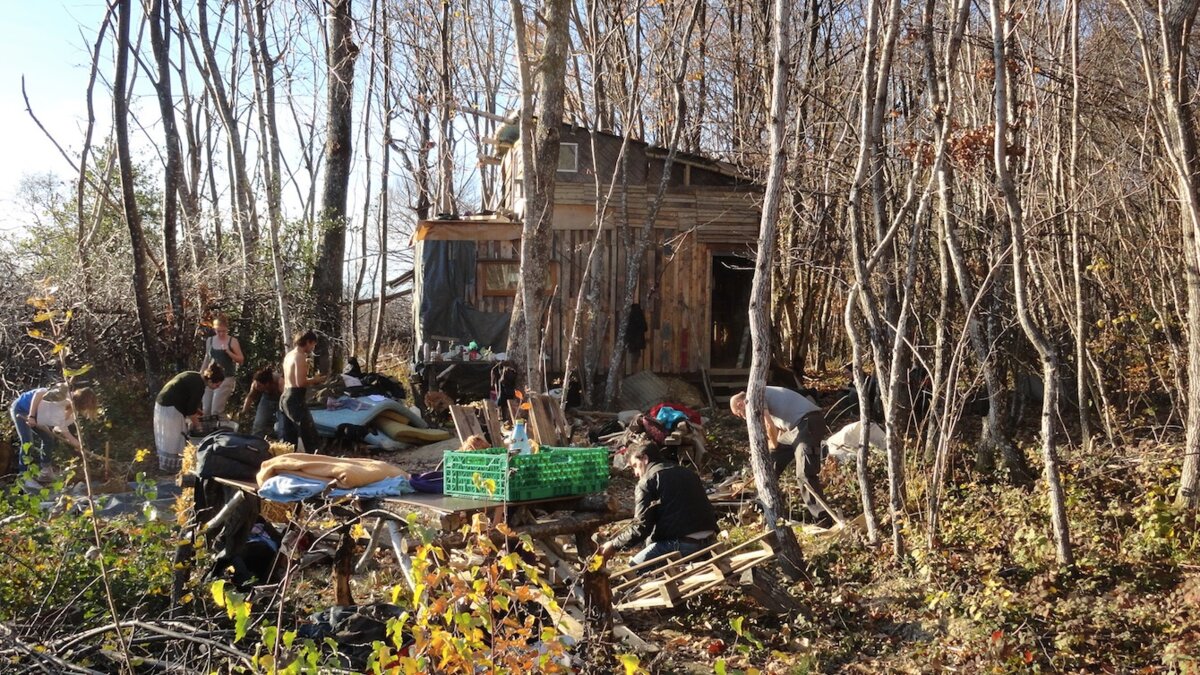
Enlargement : Illustration 1

The occupation area is known in the protest jargon as a ZAD, and its occupants as 'Zadists'. Officially ZAD stands for zone d'aménagement différé or 'future development zone', but it has been adapted by green protesters to mean zone à défendre or an 'area to defend'. On the left of the ZAD at Chambarans is a vegetable garden that has returned to its natural state under a partly-torn polytunnel surrounded by trenches filled to the brim with water. To the right are hundreds of tree trunks piled on top of each other, the result of the wood clearance work that was brought to a halt by the opponents.
A little further into the zone, the former portable cabins used by the site workmen are now open to the elements. They are covered in slogans and graffiti plus a sign with the word 'ACAB' written in perfectly rectangular black letters. This is an abbreviation of the old anarchist slogan in English 'All cops are bastards', and serves as a sign for the site's ACAB café which was still active last summer. Inside is a sofa, empty cupboards and a broken bike. The hessian roof is falling in. The scenes represents the ruins of a collective life in the open air. “Let's live everywhere,” proclaims one banner. “Because we crap on relations based on domination and norms make us sick. Here there is no sexism and homophobia.”
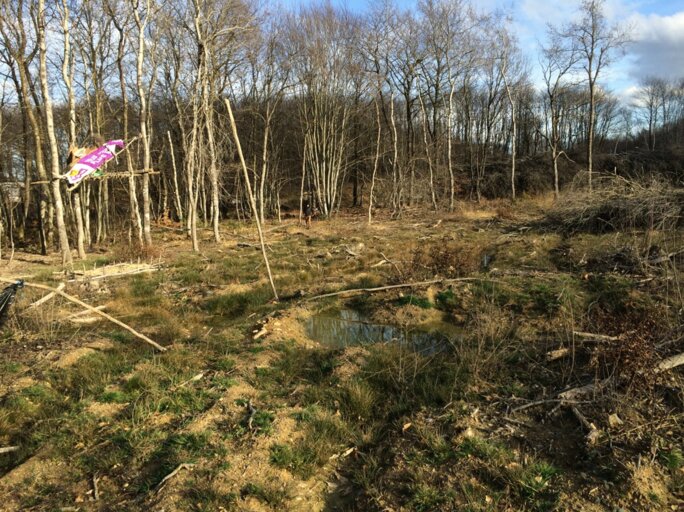
Enlargement : Illustration 2

Some men and women continue to live in the Avenières wood, at this part of the forest is called, but now under cover because of the winter cold and wet and in small groups. There are far fewer of them than at the best-known 'ZAD' at Notre-Dame-des-Landes on the other side of France, where protesters are campaigning against a new airport. Yet whether their living areas are permanent or temporary, they have been given humorous and grandiose names such as 'Pallet palace'. Among them are a hut on stilts, a kitchen-living room-sleeping area that looks like a witch's house, platforms high in the trees to watch out for hostile visitors and a watchtower on the south side adorned with the words: 'Welcome to stateless people'. Elsewhere one reads: “We will always be right to defend the forests.” Here the woods are not just décor. Yes, they are the object of the current struggle but they are also the physical setting where those who seek a utopia try their hardest to make it work.
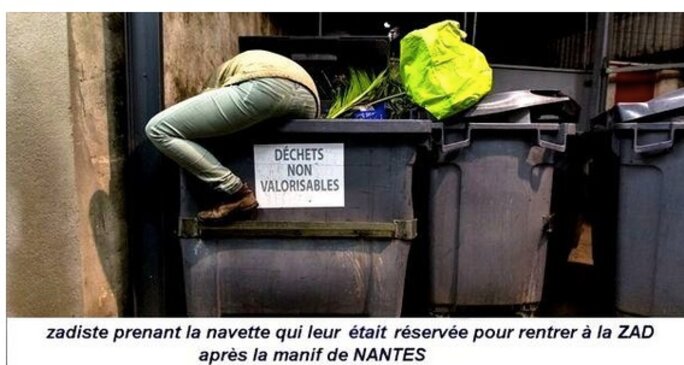
The simplest way to cross the 'ZAD' is to follow the path of the track between the trees that goes dead straight, as if drawn with a ruler. It was created before the courts stopped work on the site. “The first time I saw it I said to myself it's like a motorway,” recalls a local resident, who is also opposed to the Center Parcs project.
Another local opponent notes: “The Center Parcs project raises lots of environmental problems. But it's also a issue for society: the encroaching commercialisation of the land. Where I used to go gathering mushrooms I run the risk of finding somewhere you have to pay to get in.” But like everyone else interviewed by Mediapart, whether for or against the project, no one wanted to be named, photographed or identified in anyway. Eighteen months after the first clashes between protesters and supporters over the scheme, no one wants to appear openly in the media.
Evidence of the local hostility leaps out at you at the ZAD. Someone has daubed the words 'Bolshies out' on the front of the southern barricade. Next to it someone else has drawn a golden heart, apparently as a form of antidote to the slogan. In the northern barricade, Saboté, an unknown person has cut width ways across some wooden pillars while no one was on watch.
The Facebook page of supporters of the holiday centre project has meanwhile become a forum for those who want to give vent to their hatred of the protesters. “I'm going to have a Zadist”, “Don't forget to protect yourselves with gloves and a mask as they are so mangy that there's a risk of diseases (such as plague, leprosy, scabies)”, “These filthy bastards must be exterminated”, “Just one thing I want at this moment: to go and butcher these fucking Zadists” and “Today I went past Roybon [editor's note, the name of the village parish or commune where the centre is planned] in a lorry but unfortunately not a single person crossed in front of me” are just some examples of what people have written. Others examples include “When will these parasites be evicted” while another asks “So, are we getting rid of them?” To which came the warlike response: “Our dear government only has to send in the army and all these wankers can be made to do hard labour.”
The level of violence of these verbal attacks is inversely proportionate to the size of the village of Roybon itself, which has just over 1,200 inhabitants. Banners with the words “Yes to Center Parcs” can be seen in the streets. People who support the project say it will create jobs and make the area better known. “They say that there's nothing here, that it's good to build things there - they're not attached to this forest,” says one opponent sadly.
A whole raft of local organisations and local branches of national organisations back the Center Parcs project, including the employers federation MEDEF, the Chamber of Industry and Commerce, the CGPME which represents smaller businesses, the CFDT union, the Christian workers' association the CFTC, the artisans' body UPA and the building federation the FBTP. They say that “this project is a unique opportunity for our [local] families who hope for a job, for our artisans who are looking for orders, for our [local] small and medium-sized businesses who have trouble making ends meet at the end of the month, for the dynamism of our area”. As with the supporters of the airport at Notre-Dame-des-Landes, they also see the project's go-ahead as a mater of principle. “Unless we're mistaken we are still in a country under the rule of law, and in a democratic country, where it's the view of the majority that must be heard,” they argued in a statement.
'I want this to belong to everyone'
A small group of young men and women have lived for a few months in a building renamed 'Maquisad', outside the ZAD itself. Under the sun of a late January afternoon they are cutting wood in front of their barn. Behind them are traces of a fire in which their workshop burnt down at the end of last year, destroying their tools and part of their equipment. Fortunately the blaze spared their living area and their shop with free clothes, boots and shoes that they have set up for visitors and themselves.
When the light fades and it is time for a break the small group warm themselves up in the collective living room, protected from the cold by a door covered with a blanket. On the central table is a carrot and herbal tea cake. They are listening to music on their computer and finding out about veganFest, a vegan festival that was being held the following day at Grenoble. So, why do they want to live here? “Normal society doesn't suit me: the shops, the prison-like world, the relationships between men and women,” explains one inhabitant. So is the ZAD at Chambarans a form of refuge from the world? “No, it's a place to get experiences,” he replies.
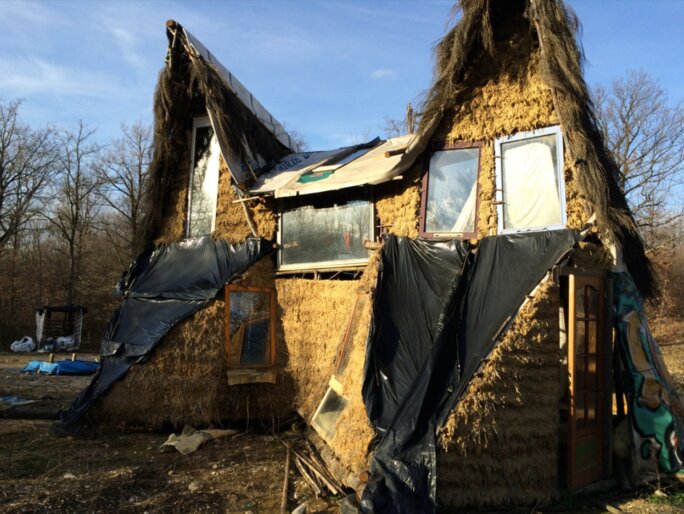
Enlargement : Illustration 4

The young man says that before coming to this wood he lived at the ZAD at Testet, protesting against plans for a dam at Sivens in south-west France. “I learnt that it was opening here, I wanted to come and see how it was going to start off. I'm happy to be here, to learn lots of things: gardening, making bricks, carpentry.” He pauses. “I would never have thought I'd do carpentry,” he adds. The young man doesn't know how long he will stay, though he does not particularly want to stay there permanently. “My wish here is that it belongs to everyone.”
There is clearly a considerable gulf between the image of the 'Zadists' held by supporters of the Center Parcs project and cultivated by some local councillors, and the reality of the protest site inhabitants. Between the repulsive idea of lazy, dirty, parasites and the reality of the young people at the ZAD, wearing boots, hammer and saw in hand, a forehead light in their hair, working and committed to an ideal of freedom and justice.
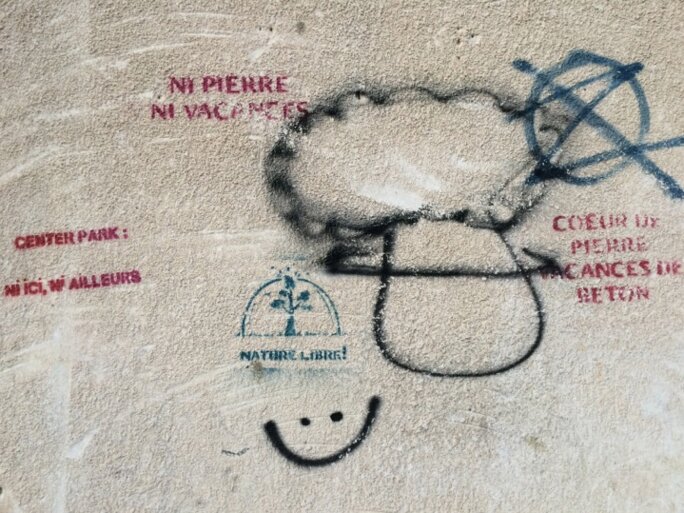
Enlargement : Illustration 5

This difference in perception about the protesters also masks another potential gap in perception when it comes to supporters of the project: in the name of which law do they claim to be acting? Those of the 'declarations of public utility' and decrees from state prefects that are nearly always in favour of development projects? Or those highlighted by the public inquiry which gave a unanimous opinion against the construction of the Center Parcs centre? The report noted that the site is “sensitive in environmental terms” owing to the presence of an important area of flora and fauna, wetlands and environmental corridors.
Moreover the site is at the head of a geographical catchment basin with waterways “sensitive to various [forms of] pollution, even low-level”. The scale of the clearance work necessary for the project - over at least 90 hectares with 83 hectares of this being wet woodland – was “concealed” in the reports, says the inquiry. And the scale of the destruction of the wetland area had been “under-estimated”. The inquiry also said that the corrective measures were “insufficient”, as was the proposed work to safeguard the flow and quality of the water.
These fundamental arguments have, however, become obscured by the creation of a new public enemy, the 'Zadists', whose eviction has now become a priority. The appeal for law and order, a tactic that has been deployed not just at Roybon but at Sivens and Notre-Dame-des-Landes too, has prevented people from grasping the major environmental issues involved in all these cases. In such circumstances it has been difficult to get across the importance of wetland areas, forests and looking after the soil and the protection of water at a time of climate disorder. However, all such development projects are confronted with these questions. They are key issues, yet systematically ignored by elected representatives and political commentators.
Meanwhile the protesters at Chambarans continue their vigil, away from the gaze of the mass media. Unlike their counterparts at Notre-Dame-des-Landes – the scene of another high-profile protest on Saturday February 27th - the forest dwellers at Roybon do not have the support of local country people. This leaves them both more isolated and, without doubt, more vulnerable.
--------------------------------------------------------------------
- The French version of this article can be found here.
English version by Michael Streeter


